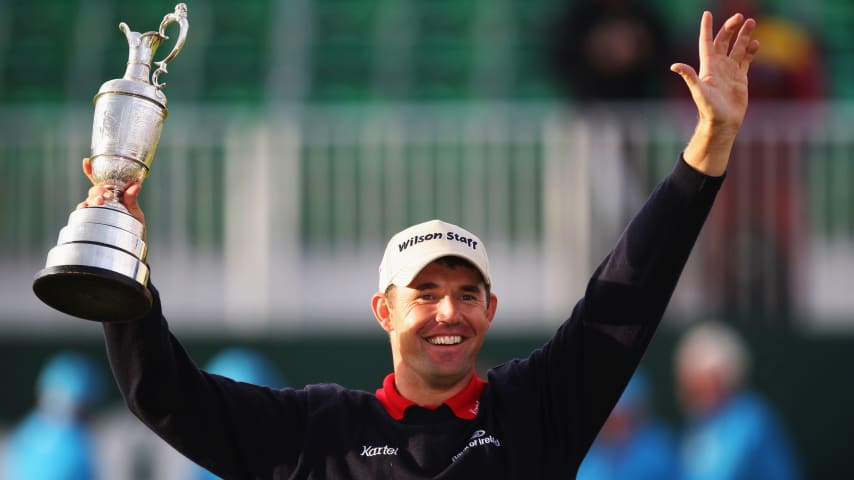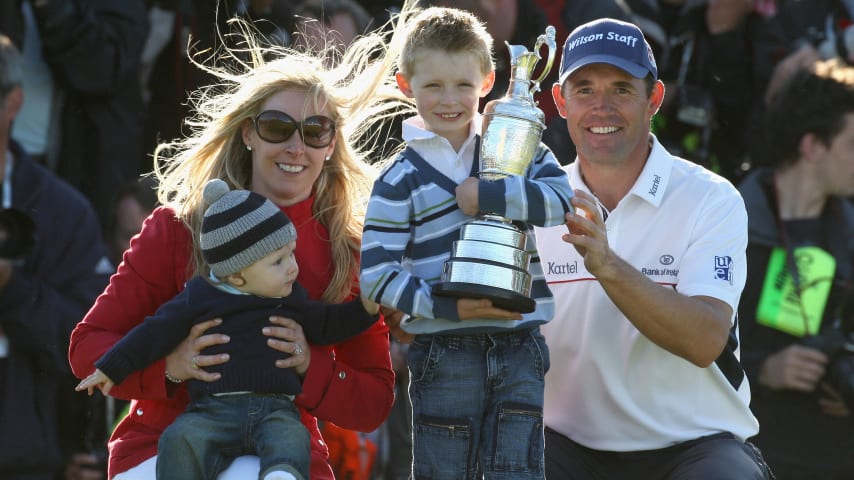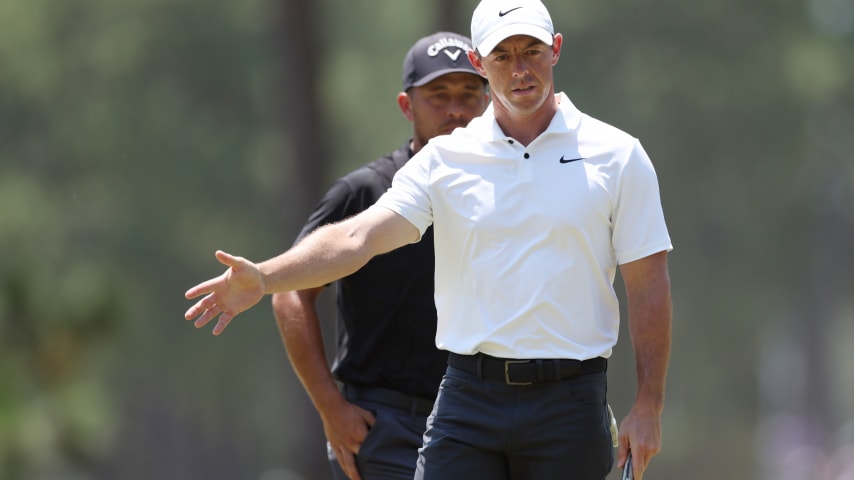Padraig Harrington reflects on career defined by persistence, passion before Hall of Fame induction
12 Min Read

Padraig Harrington celebrates with the Claret Jug after winning The 136th Open Championship at the Carnoustie Golf Club. (David Cannon/Getty Images)
Written by Sean Martin
Padraig Harrington’s induction into the World Golf Hall of Fame on Monday is an opportunity to reflect on a career defined by perseverance.
His route to enshrinement was a unique one. He didn’t turn pro until he was 25 and after completing his studies in accounting. He was the son of a police officer, growing up on a public course that he and his four brothers helped build.
He was the consummate grinder, a player whose results exceeded his appearances. He relied on a strong short game and plenty of guile to play in three Walker Cups during his amateur days. In his first event on what is now the DP World Tour, his playing partner wondered aloud why Harrington was even considering turning pro.
“I had a resilience, I had toughness,” Harrington said. “I had a ‘just get it done’ attitude.”
Harrington’s no-nonsense approach and tireless work ethic eventually turned him into one of the world’s best players. He won three majors in a two-year span – the 2007 Open, followed by The Open and PGA Championship in 2008 – and is a 15-time winner on the DP World Tour. He also holds six PGA TOUR wins and was once ranked No. 3 in the world, behind only Tiger Woods and Phil Mickelson.

Padraig Harrington poses with the Claret Jug and Wanamaker Trophy following his wins in the 137th Open Championship at Royal Birkdale and the 90th PGA Championship at Oakland Hills in 2008. (David Cannon/Getty)
Even in his 50s, Harrington is still enthralled with the game and hoping to pass that enthusiasm on to amateurs. His continued curiosity is something that players of all abilities can relate to.
Harrington is part of the World Golf Hall of Fame’s Class of 2024 that will be inducted Monday in Pinehurst. Days before the ceremony, he spoke with PGATOUR.COM to reflect on his career and share his secrets to success. (Note: This interview has been condensed and edited for clarity.)
PGATOUR.COM: What comes to mind as you prepare for your induction into the World Golf Hall of Fame and reflect on your career?
PADRAIG HARRINGTON: When you're winning, when you're going through it, you kind of expect that it's going to continue to happen so you don't get too caught up in it. You tend to just get on with it. You're always thinking about the next win. Whereas at this time in my career and with the Hall of Fame looming, it is very much time to take stock and have a nice reflection on what I've done. And it's very satisfying.
PGATOUR.COM: What is the source of that satisfaction?
HARRINGTON: Well, I think I've always felt I've far exceeded my own expectations. But when you get to the Hall of Fame, you realize that actually you've achieved on a whole different level. There's not that many golfers that get into it. You don't get into the Hall of Fame for anything but your performances. That's it. This is an opportunity to look back and say, ‘You know what? You did well.’
PGATOUR.COM: You've said before that you weren't the guy who looked destined to be great. What was your secret to getting the most out of your talents?
HARRINGTON: I was always somebody who just did it, got it done.
If you're looking at my strengths, it’s a couple of things, I'm a real good optimist. I really do look forward. I'm not somebody who looks at the past. And in many ways, my greatest trait, especially early on in my career, actually all the way through my career, even as an amateur, I always was able to dominate at every level I got to.
I was very good, wherever I was, at looking around me, seeing what I needed to do to beat the guys next to me, and doing it.
I kept my head down and did it. They’re talking in sport now about marginal gains, but that's exactly what I was doing all my career. I was just improving my weaknesses at all times, knowing that I had a few special traits, you know, being my character, my strength of mind, my fortitude, my good attitude on the golf course. And I was happy to work away and improve the weaknesses.
My old coach, Bob Torrance, said you never want to weaken your strengths to strengthen your weaknesses. But I was very good at identifying what I could improve, and for the most part of my career I certainly kept the strengths strong and improved those weaknesses.
“I was very good, wherever I was, at looking around me, seeing what I needed to do to beat the guys next to me, and doing it. I kept my head down and did it.”
Padraig Harrington
PGATOUR.COM: You were 24 when you played your first DP World Tour event. You’ve told the story of your playing partner telling people, ‘I don't know what this guy thinks he's doing, turning pro.’ What does it say about just the distance you've come?
HARRINGTON: I think I probably would have said the same thing. But it's very hard to see what's behind the character. It's very hard to see that ‘X factor.’ And at that stage, I'd just gone six years being unbeaten for Ireland.
I would have been the perfect candidate for “The Masked Singer.” I was a much, much better player than I looked. And when I got out on tour, I improved the look of things.
But I had the ‘X factor.’ I had a resilience, I had toughness. I had a ‘just get it done’ attitude. I wasn't a follower in any shape or form.
PGATOUR.COM: That started with the course you grew up on. Not many World Golf Hall of Famers have helped build the course they grew up on.
HARRINGTON: I was brought up on a very, very tricky golf course. I'm talking a course that you definitely couldn't hit six greens in regulation on this course in the summer, not a chance. So if you were going to shoot anywhere close to the level of par, you had to get up and down at least 12 times and never miss. And I didn't think anything of it.
If you were brought up in Phoenix where it's beautiful sunshine, pretty calm, you're going to have a perfect golf swing. If you're brought up in Ireland on Stackstown Golf Club up the side of a mountain, if you become a good player, it will be because you've learned how to play the game, how to get the job done. It won't be to do with hitting the ball (high) in the air.
One of my earliest memories is helping level the 12th green, the sand on the green with my little feet when I was 5 years of age. Everybody pitched in when this was built by manual labor. It was a community effort amongst the police and everybody chipped in. It was my playground growing up.
PGATOUR.COM: The 5-wood at Birkdale, hitting it to 3 feet on the 71st hole to make eagle and lock up the 2008 Open, is probably the most famous shot of your career. But you’re also very proud of the pitch shot to save double bogey on the 72nd hole of the 2007 Open at Carnoustie, which was your first major win. Walk us through that shot.
HARRINGTON: At Carnoustie, it's the only time I hit two bad shots from being in a commanding position, feeling overconfident on the 18th tee. I then hit two bad shots, well, a bad tee shot. And then I had a complicated second shot that didn't hit well. I felt like I'd lost The Open.
I felt devastated, the only time I've ever felt like that on the golf course. I never felt like I let people down and I did there. Because with a one-shot lead and with the way I was playing, it was mine. I think to get back in the zone, my caddie was talking to me. He went through all the different mantras.
I think he took the 4-iron from me because I wanted to hit him with the 4-iron. I don't give up easy and it probably was the only time I might have given up. And he just kept talking to me and talking to me. And by the time I got near my ball, I started to listen. And then by the time I hit that chip shot, I hit it like a teenager showing off. I was right back in the zone.
I fired it in there; everybody thought I'd hit it thin over the green but it was spinning and I was like, it's got to spin. I was exactly like a kid. So it was an exceptional shot I hit there. Bob Torrance used to say it's easy to hit a great shot when you're feeling good. It's really difficult to hit a good shot when you're feeling bad. And I'm not saying I was feeling bad when I hit the shot, but I came from one of the lowest points I could say in my golf ever and hit a great shot.
So I put that down as the best shot. Everybody else will remember the one on the 71st hole at Birkdale. I hit a few great ones, I can tell you, at Oakland Hills (in his win at the 2008 PGA) because I was really shaky in terms of my confidence in my game. I'd hit some really poor shots Thursday and Friday on the back nines when I got discombobulated, I got dehydrated.
“I've always loved it. I've always been obsessed with the why.”
Padraig Harrington
PGATOUR.COM: On one level, you have great consistency in your career. You’ve used the same caddie for years, same club company, I believe same agent as well. But you've said that one constant for you is you were always changing. What is it about keeping the things around you constant, but you always willing to change yourself and your game to get better?
HARRINGTON: I think it's always been changes in the long game. I've never ever worked on my technique on a chip shot. Not a lot in my putting. You know, I've worked tirelessly on my mental game, but I've never played with a swing thought since 1997. So that's been constant. I always use the target as my thought. I purely work on Bob Rotella’s stuff. So I trust that.
The only thing I've always been drawn into is trying to find the secret, trying to find a golf swing that could overcome the mental game, which is impossible. It's not going to happen. No golf swing can defeat a bad self-talk and vice versa. It doesn't matter how bad your golf swing is. If you think right, you're going to get the most out of it. And if your golf swing is brilliant and you think wrong, you're going to get the worst out of it. But there still is this attraction to building a golf swing that I think could overcome a mental error.

Padraig Harrington celebrates with the Claret Jug with wife Caroline and sons Patrick and Ciaran after winning by four strokes during the final round of the 137th Open Championship in 2008 at Royal Birkdale Golf Club. (David Cannon/Getty)
I think coming from where I came from with a golf course with no practice ground – my practice ground was a hundred yards long – I never ever worked on my golf swing. The conditions weren't really good for it. I was always, I was a kid in a candy shop on tour. I was always going to get drawn into beautiful ranges, beautiful facilities and trying to make my swing flawless. And I still do. I get up every morning and I'm still trying to find the secret.
Logically, I know it's not there and logically, I kind of know it's not of any use. But this is what keeps me going, keeps me motivated. There's no doubt I've been stereotyped as somebody who changes. But, you know, the reality is I had the same coach from 1987 to ‘98, from ‘98 to 2013. So I didn't change coaches. People say, ‘You were changing.’ When I went to Carnoustie (for the 2007 Open), I was trying to hit a draw. I won at Birkdale playing a fade.
And this really startles people. My performances were much better in 2009 than they were in 2008. They were even better in 2010 except for in the winning category and the strangest thing of all is in 2013 I had my best year tee to green, ball striking, but at that stage things had gone a little awry with the putting.
I kind of fit this narrative. I called this early on in my career. Pro careers last 20 years, 15 good years, another five years sort of tailing off and after 20 years they're burnt out. You get two years, 18 months basically, usually two seasons, where you peak, and after that peak you're never as good. And pretty much everybody fits into that.
I fit exactly and people think I say that because I fit the category. I was calling that before this and it's strange. I knew it. I fell right into that category. And it's interesting because I tell you, I played better in 2009, 2010, better ball striking, but that doesn't matter, does it? Because when did you win? And that's all that counts.
“It doesn't matter how bad your golf swing is. If you think right, you're going to get the most out of it. And if your golf swing is brilliant and you think wrong, you're going to get the worst out of it.”
Padraig Harrington
PGATOUR.COM: Well, as we close, I think one thing that people are impressed with, just as much as your resume, is how you're someone who's still deeply enthralled with the game. You love it. You love trying to find it, trying to discover new things, share your knowledge with people now on social media and in pro-ams. And I just want to ask, what is it about this game that's kept you enthralled for three decades or even more?
HARRINGTON: I've always loved it. Thankfully I recognized when I was burned out, it wasn't golf. It was the pace I was going at. You know, Scottie Scheffler at the PGA this year was two tee times ahead of me. Right. He was arrested and I was still in my bed.
I was Scottie Scheffler back in the day in terms of I would have been there like 3 ½ hours early. That's what you’ve got to do when you're a young man. When you get a little bit older, you just can't keep that pace up. You've got to sit back and either you give up or you figure out a different way of enjoying it.
I've always loved it. I've always been obsessed with the why.
I love the etiquette of the game. This is crazy. I love the fact that you don't get a drop out of a divot. I think that's one of the greatest rules in golf, because golf was never meant to be fair. It was never a fair game. It's a test of the mental and physical capabilities.
That's what we did as kids with my family. We talked around the dinner table about the nuances of the rules. We were all into it.





